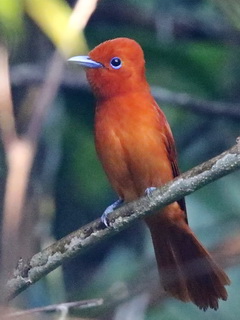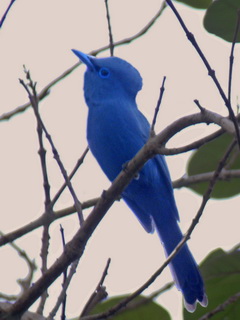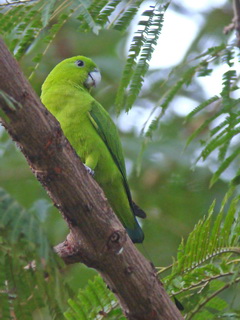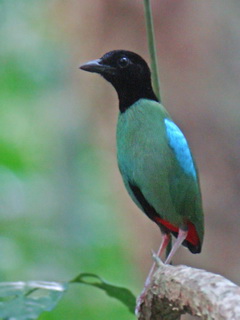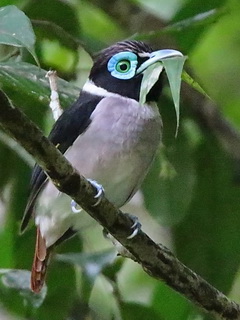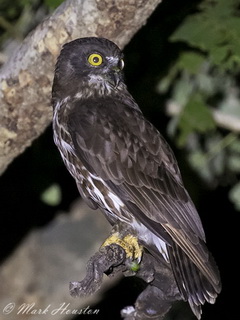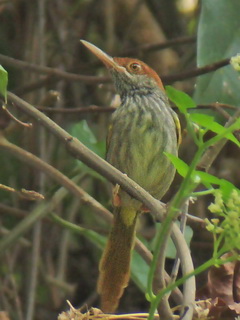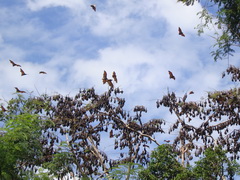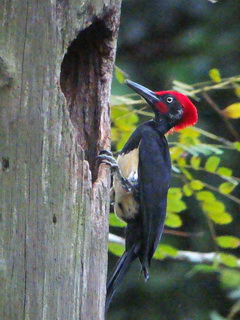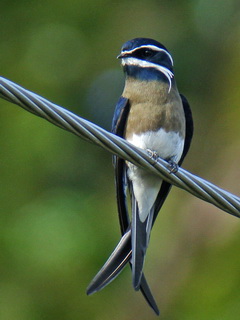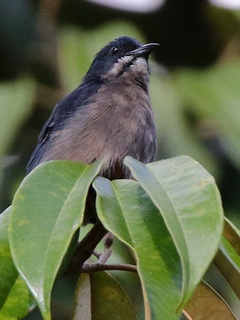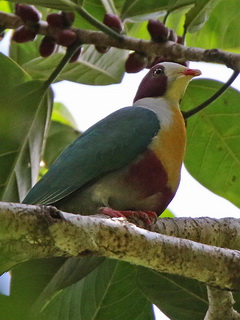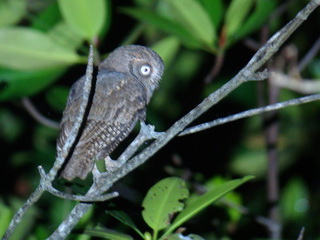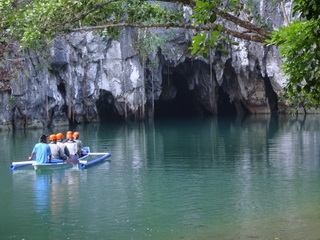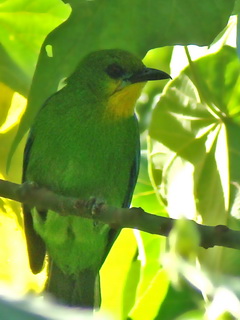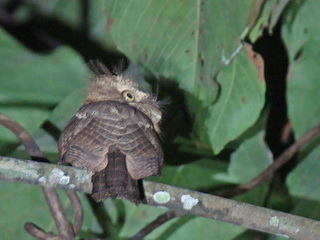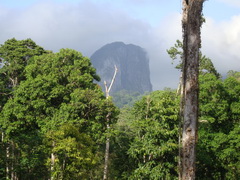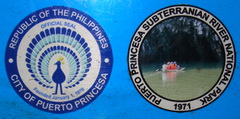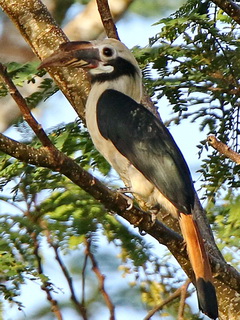B2A Philippines 2016 tour
report.
Luzon, Mindanao, Palawan
15 February - 1 March
Participants; Tim Key from UK,
Johni Paakkonen from Sweden,
Mark Houston from USA, Calvin Hill from USA
William Price from UK, Shane Woolbright from USA.
Tour leaders; Stijn De Win &
Pete Simpson
Candaba, Subic,
La Mesa, Angono, Makiling,
Mt. Kitanglad, Davao, Picop
Sabang-Underground River, Irawan Eco Park
What a privilege again to have led a tour where just about every other bird is a lifer even for the most travelled or experienced guests. Indeed, with so many endemic birds to go for the Philippines must be an excellent choice of destination. And yes, all was truly enjoyed by all participants. The feedback I got after this tour was so incredible positive that I can’t resist posting a couple after-tour emails at the bottom of this page. And promised, all copy-paste without any modification!!
Mark had told me this would be a bucket list trip and I’m sure this was delivered upon as we missed only very few species. For Calvin this trip was no less than sort of going home as he had lived very near Kitanglad in his childhood. Indeed he did no effort hiding his enjoyment of being back in the Philippines getting all the birds that had not been a focus on any previous of his stays. Johni was a little quiet as far as voice concerns but this didn’t mean he did not fit perfectly in our group. Someone just busy enjoying the birds and the warm pleasant weather will always be welcome on our tours. Shane self-claimed to be my best ever client so who am I to deny this. Despite his keen interest in Palawan stink-badgers he was always very quick on the birds, which of course was of great help to all. William may have been the keenest in the group for getting some opportunity photos along. He certainly placed some excellent results and I have included a link to his photos below. Tim needs a special mention as he had almost missed the tour. We helped, he came, and he went home with only super great memories.
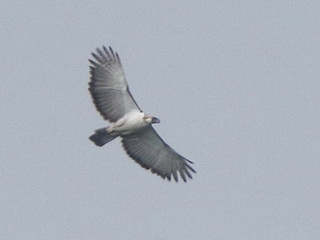
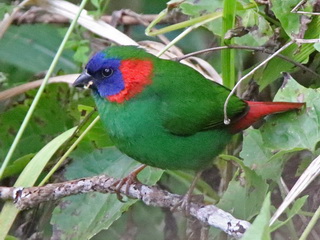
Power and colour on Mount Kitanglad; The Philippine Eagle and Red-eared Parrotfinch. Photo © Pete Simpson
This was our second tour of the year which became another exciting adventure producing innumerable highlights. I’ll keep to a short list of top-birds for this intro; Ashy Thrush, Green Racquet-tail, White-fronted Tit, Chocolate Boobook, Scale-feathered Malkoha, Spotted Wood Kingfisher, Philippine Eagle, Red-eared Parrotfinch, Blue-capped Kingfisher, Rufous Hornbill, Apo Myna, Philippine Frogmouth, Wattled Broadbill, Azure-breasted Pitta, Silvery Kingfisher, Blue-backed Parrot, Philippine Cockatoo, Palawan Peacock Pheasant… Additionally, being a Kingfisher enthusiast, I should not hide that we did see no less than 12 species of kingfisher on this tour; just about the maximum number possible indeed.
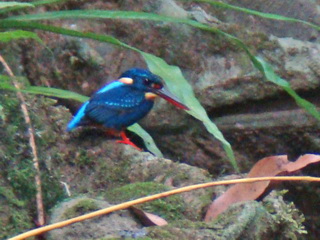
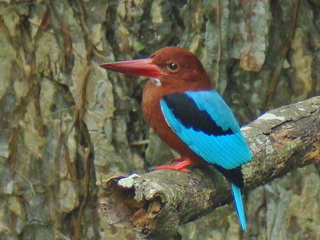
This included quite a few endemic ones like the Indigo-banded Kingfisher
and Brown-breasted Kingfisher from Mt. Makiling. -Photo © SDW
From the hotel in Manila we began the tour with a visit to La Mesa Ecopark. An easy stroll quickly produced a good selection of species including a first few endemics like Guaiabero, Pygmy Flowerpecker and Philippine Woodpecker. Of course we were after the park’s Ashy Thrushes. They never seem to perform very early and it was only at about 9am we struck gold with brilliant prolonged views of one bird foraging undisturbed on the forest floor. On our way out of the park we did check the usual Ashy Thrush stake-out again and indeed another bird was seen here briefly. Hearing an Indigo-banded Kingfisher alarmed us to be ready for its appearance. At La Mesa this very often isn’t more than a fly-by and indeed we did catch the incredible bright blue flash when it crossed the track. Luckily we could later enjoy good perched views of this magnificent kingfisher at Makiling Botanical Garden.
A short midday visit to Candaba Marsh held a first surprise as an Eastern Grass Owl seen in flight had apparently been flushed by a rice harvester. Philippine Duck (500+ present) and Philippine Swamphen (5+ birds seen) were of course the important targets. To witness the ‘last’ pond of Candaba absolutely crowded with ducks was rather spectacular; 1000s Garganey, Northern Pintail, Northern Shoveler, Wandering Whistling Ducks and Eurasian Teal were joined by a few species scarcer for the region; Tufted Duck, Common Pochard and Eurasian Wigeon. For those not too keen on ducks the marsh always does hold some other pleasures; Painted Snipe (male and female seen), Eastern Marsh Harrier, Barred Rails, Pheasant-tailed Jacana (3 birds), Yellow Bittern, Cinnamon Bittern, White-browed Crake, Watercock, Long-toed Stint.
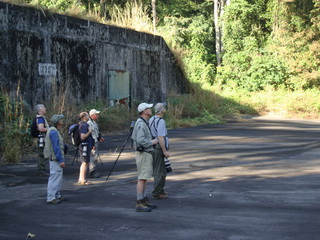
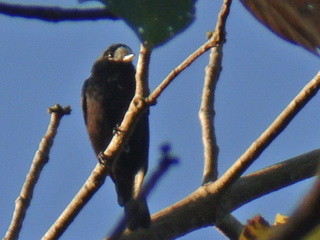
And we're lucky with the hard to find 'top-target' White-fronted Tit indeed!
‘That’ many birds present at Candaba proved an excellent
delay as it made us literally dive into the birdlife at
Subic during no more than half an hour of daylight left. We
hit the incredible bird activity hard and had no chance to
park the van properly as a Spotted Wood Kingfisher was
already heard from the moving vehicle. Two minutes later the
Kingfisher was posing for photos.
New birds appeared in quick succession; Coleto, Beer-bellied
Cuckoo-shrike, White-browed Shamas singing, Slender-billed
Crow, Balicassiao, Colasisi, Elegant Tit. Great views of a
group of Rufous Coucals meant another important target for
us went in the bag. This was a brief but superb start at
Subic which means with a day and a half left we’re on
‘target’ schedule and all looking very good indeed.
We did not slow down the next morning and soon many Subic
specialities were showing well; Sooty Woodpecker, Luzon
Flameback, White-bellied Woodpecker, Blue-naped Parrot,
Green Racquet-tail, Red-crested Malkoha, Luzon Hornbill,
Eastern Blue Rock Thrush, Rufous-crowned Bee-eater,
Stripe-headed Rhabdornis, Luzon Hawk Eagle, Philippine
Falconet and after some work a secretive Trilling Tailorbird
lured into the open good for photo opportunities.
Once lunch, some rest/swim and the midday heat was over we
experienced an afternoon that was equally productive with
Philippine Green Pigeon, Whiskered Treeswift, more
Woodpeckers, Rufous Coucal, Dollarbird and White-browed
Shama for good views before we heard Great-eared Nightjar,
Philippine Scops Owl and Luzon Hawk Owl. We finished in good
fashion with the same Chocolate Boobook from our first tour
this year posing for photos in exactly the same roadside
tree.
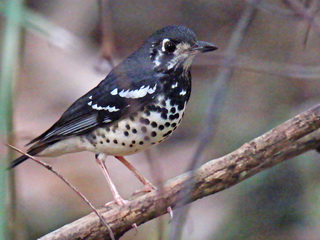

Ashy Thrush, La MesaGuaiabero, Subic ; photos SDW
On our last Subic morning we were looking at finding two
remaining targets. Blackish Cuckoo-shrike was easy enough
and with 5 birds seen it just left us wondering why we had
not connected on the previous days. Another Subic
top-speciality usually requires a bit more luck if not skill
to find. We must have had both qualities in our group as a
single White-fronted Tit indeed showed brilliantly. As a
happy group- satisfied with the birds Subic has on offer- we
moved on, back to Manila for some birding stops on our way
to Mount Makiling. A Philippine Hawk Cuckoo showed low in
some bamboo at the Diliman University but the daytime
stake-out of Philippine Scops Owl failed to deliver the
birds on this particular day –reason unknown.
At Angono the Philippine Eagle Owls have not been breeding
this year and subsequently very few birders have managed to
see them. Despite this we have had the luck to enjoy a
superb daytime Eagle Owl on our first tour just two weeks
earlier. This time however we could not repeat the trick and
3 busloads of school kids visiting the Petroglyps site near
the stake-out must not have helped either. However at a
quiet moment during our visit the sound of a Scale-feathered
Malkoha was picked up and the bird duly tracked down to a
spot where it sat for the next 20 minutes or so. No need to
say it ‘saved’ our visit.
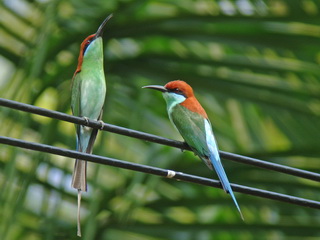
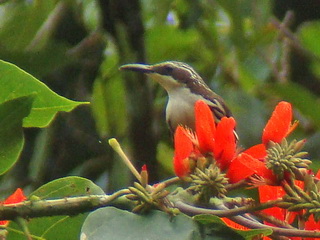
Rufous-crowned Bee-eater, SubicStripe-headed Rhabdornis, Makiling
At Makiling we had early success with pre-dawn Luzon Hawk Owl showing before we set off on the forest track. Low bird activity is pretty normal at Makiling so it was merely seeking out some targets beside the Luzon Hornbills, Ashy Minivets, Balicassiao, Purple-throated Sunbird, Philippine Serpent Eagle and Orange-bellied Flowerpecker. Handsome Sunbird, Grey-throated Sunbird, Striped Flowerpecker, Buzzing Flowerpecker, Philippine Cuckoo Dove and Yellow-wattled Bulbul all showed briefly. We rounded off the morning with a nicely perched Black-chinned Fruit-Dove.
The afternoon had us visiting the Makiling Botanical Garden and we met with success finding a perched Indigo-banded Kingfisher. Later, the open areas near the Dairy Husbandry and rice irrigation institute on the university campus gave us some relaxed birding. A Barred Buttonquail first appeared and we could enjoy watching a Peregrine eating dinner perched atop a pylon; tasty White-breasted Waterhen was on the menu. Oriental Skylark, Buff-banded Rail, Tawny Grassbird and Ameline Swiftlet were new birds for the trip.
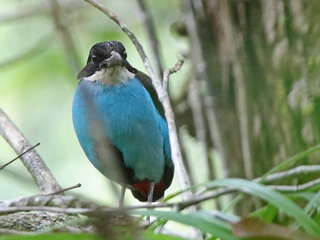
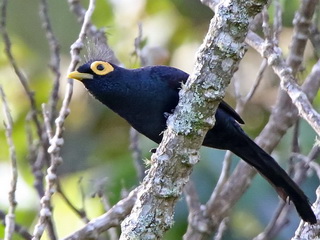
Azure-breasted Pitta, PicopApo Myna, Kitanglad ; photos © Pete Simpson
Mindanao has been suffering drought for many months due to a strong El Nino. This was evident on the drive from Cagayan de Oro airport to the drop point for Mt Kitanglad as we passed through the brown parched landscape. From the drop point the walk up to Del Monte Lodge was made easier by the lack of rain, the river we traverse was barely a trickle and the few sections of the trail that are usually slippery were dry and dusty. On arrival to the forest fragments around the lodge they seemed quieter than usual and we feared El Nino would make birding difficult. That proved true only for night birding as we had little response on the first night.
On the first morning walk up to the eagle watch point we started to work our way through the list of desired Mindanao montane endemics; Black-and-cinnamon Fantail, Rufous-headed Tailorbird and Grey-hooded Sunbird were enjoyed first. From the eagle watch point we added Mindanao Racquet-tail and Apo Myna. Later in the morning the raptors were active with five Oriental Honey Buzzard in the air at one time. Another treat was a very close Rufous-bellied Eagle putting on an excellent display. We picked out Philippine Eagle in the afternoon, flying then perched in full view. That was a massive relief as this most prized bird has been tough this year. On the way down and close to the lodge we met some good mixed flocks and added Mindanao White-eye, Olive-capped Flowerpecker, and Cinnamon Ibon.
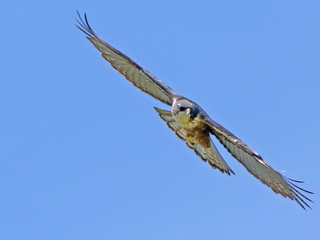
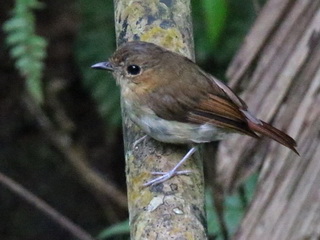
Rufous-bellied Eagle, KitangladCryptic Flycatcher, Eden-Davao ; photos © Pete Simpson
Getting the eagle on the first day allowed us to push
higher on the second full day for Apo Sunbird. We headed up
at a slower pace than the previous day, getting on to
Red-eared Parrotfinch and then Long-tailed Bush Warbler in
the early morning. Soon after the eagle watch point we were
in closed canopy forest and heading higher. We picked up the
McGregor's Cuckoo-shrike in a mixed flock and arrived at
1800masl before lunch time. We were soon on to a pair of Apo
Sunbird which responded well and perched obligingly above us
for the photographers in the group.
Lunch was delivered to us in a cool forest area where we got
on to a responsive Philippine Hawk Cuckoo. On our last night
up the mountain the Philippine Frogmouth called close to the
lodge and was tracked down by Carlito and seen well by
torchlight. Before our walk down on the last morning we were
able to photograph a stunning male Fire-breasted
Flowerpecker next to the lodge and get on to a migrant
Blue-and-white Flycatcher, a real rarity down here with only
a handful of records before for Mindanao.
From Bukidnon we headed to Davao and after a restful night we were up at Eden for Cryptic Flycatcher. Inside the resort we got on to Ruddy Kingfisher then a quick view of Silvery Kingfisher before a pair of Cryptic Flycatcher appeared from the dark undergrowth. Higher up the mountain the Whiskered Flowerpecker responded quickly and we were on our way to Bislig by 10h30am. First stop at Bislig was the old airfield where we recorded Philippine Duck, Philippine Nightjar and watched a great display from Eastern Grass Owl.
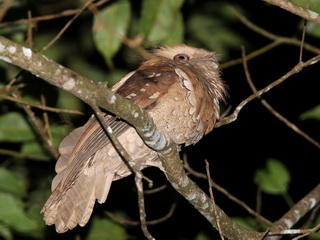
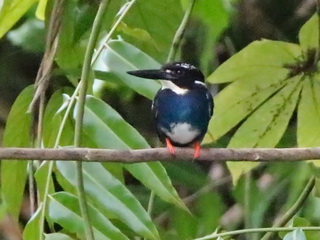
Philippine
Frogmouth, KitangladSilvery Kingfisher, Picop ;
photos © Pete Simpson
El Nino did not lessen the regularity of showers at PICOP, but the intermittent rain did not dampen our birding spirits. We started on Road 42 and what a first day with top-targets as Azure-breasted Pitta, Wattled Broadbill and Blue-capped Kingfisher. We picked up the Wattled Broadbill as it flew in, we saw it, it saw us and froze, and remained frozen for long enough to get the whole group on to it and take a card full of photos. The support cast in this area that still has some old trees is long with Black-and-white Triller, Black-bibbed Cuckooshrike and Philippine Leafbird. The Davao subspecies of Pygmy Flowerpecker gave us a shock as it really looks nothing like those depicted in the book. Later we stopped at the Silvery Kingfisher stake-out and the bird was faithful to its spot, a relief to those who missed it the previous day in Davao.
Day two on roads 1 and 4 was no less exciting, starting with a pre-dawn Rufous-lored Kingfisher. The Blue-crowned Racket-tail performed well and our record of Blue-backed Parrot maybe the first for 10 years. We did well with the sunbirds, Handsome and Metallic-winged Sunbird, Orange-tufted Spiderhunter and Naked-faced Spiderhunter. Mixed flocks held Mindanao Blue Fantail, Rufous Paradise Flycatcher and a stunning male Short-crested Monarch. To add to yesterday's Azure-breasted Pitta experience we were lucky enough to see an adult on the nest today, viewed through the scope from a safe distance.
There are still plenty of birds at PICOP but some bird species are almost gone now. Few noticed the demise of Sooty Woodpecker on Mindanao as they are an easy bird at Subic, but now they are split by some we realize how difficult it is to see Southern Sooty Woodpecker. Little Slaty Flycatcher was near absent last year but present again this year, but how long before it is gone for good? The re-appearance of Blue-backed Parrot after so many years is unlikely to be a positive sign, more likely they have been displaced as the illegal loggers have recently arrived at a previously unreachable area of forest. However 1 fact is clear; for now PICOP remains the number one lowland birding site on Mindanao.
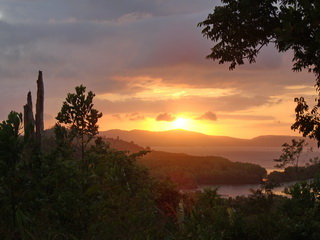

Sunset at the Cockatoo Viewpoint on PalawanBoat trip for Mantanani Scops Owl
After all the Mindanao success it was time for Palawan, the last section of the tour and we were eager to end on a high. Bird activity at some Palawan localities seemed to suffer from the dry conditions however this was certainly not true for the Ecopark near Puerto Princesa. After the flights from Davao, via Cebu, everyone in the group was super enthusiastic when plenty new endemics showed as we hit this ‘new island’ with just a couple of daylight hours left; Palawan Hornbill, White-vented Shama, Palawan Flowerpecker, Lovely Sunbird, Palawan Tit, Blue Paradise-Flycatcher, Palawan Crow, Ashy-fronted Bulbul, Palawan Bulbul, Blue-headed Racquet-tail, Ashy-headed Babbler… Putting on an appearance were also a few non-endemic goodies; Oriental Dwarf Kingfisher, Grey-faced Buzzard, Blue-naped Parrot and Rufous-tailed Tailorbird. And how to make a good Palawan start even better when daylight has gone…? Mantanani Scops Owl of course; showing well on a tiny islet reached via a tranquil 15 min. boat ride.
The next morning we knew already the Ecopark should be productive again so we’re all anticipating some great rewards. We start with rather perfect views of Melodious Babbler which is a prize as this skulker doesn’t occur near Sabang were we’ll be birding for the last couple days of the trip. Palawan Tit showed better than yesterday, a good catch up for some in the group. We also improved on Blue-headed Racquet-tail. Fly-over turned into perched; ‘quality sighting’ in the bag! Blue Paradise-Flycatcher also performed for photos this time before we continued with some new birds for the trip; Blue-eared Kingfisher, Pale Spiderhunter, Greater Coucal, Philippine Fried Pantail, Palawan Swiftlet, Palawan Drongo, Yellow-throated Leafbird and Purple-throated Sunbird. Then Johni finds us a true jewel of the forest, a ‘very’ well showing Spot-throated Flameback which we all enjoy and photograph for ages. In ‘birders language’ this translates to ‘walk-away’ views, fair enough when a sumptuous lunch is waiting!
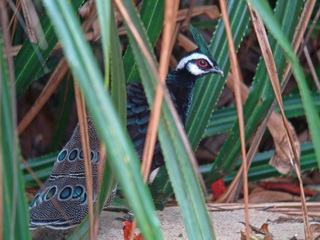
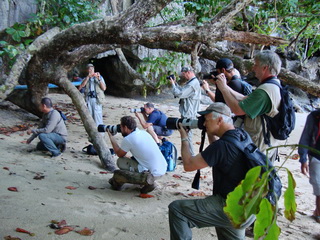
Palawan Peacock PheasantPheasant on view means birders in action!
In the afternoon we bird at various spots along the Sabang
road. We tracked down another endemic, Sulphur-bellied
Bulbul, but with things a bit quiet we mainly had time to
focus on some good looking non-endemics; Asian Fairy
Bluebird, Oriental Dollarbird, Hill Myna, Chestnut-breasted
Malkoha, Crested Serpent Eagle, Crested Goshawk, Emerald
Dove, Green Imperial Pigeons and Thick-billed Green Pigeon.
No need to mention all this was just a relaxed introduction
to the area as we had set a priority for the late afternoon;
Cockatoo viewpoint! And yes, it wasn’t long before we were
enjoying an iconic location with a superb trio of sightings;
7 Philippine Cockatoos, Palawan Hornbills and a marvelous
sunset. Surprise find was a perched Changeable Hawk Eagle,
dark morph.
In the evening we got very close to a calling Palawan Scops
Owl but after an hour of continuous effort we would realize
a couple facts both positive and negative. Good to know was
that the Owl simply must have been smarter than us on this
occasion. Unfortunately we must also admit that the birds
had already been taped out even though this was at a new
location for this year. A little later we got to celebrate
nevertheless, with great views of a Palawan Frogmouth.
One major birding destination remained for the tour and as always this was an important spot to visit. Stork-billed Kingfisher, Hooded Pittas and Philippine Megapode were just the supporting cast here as the ‘Underground River ‘ ranger station is still holding the 1 male Palawan Peacock Pheasant and this still seems the only 1 bird of its kind available for bird watchers on a brief visit. To marvel at the beauty of this Peacock Pheasant would be a once in a lifetime experience for most of us and this pretty much brings me back to where I started this report; a true privilege to re-visit and guide in these special places it is. I want to say thank you to an exceptional fine and fun group and confirm that is was great again to share the knowledge and experience of birding together in the Philippines.
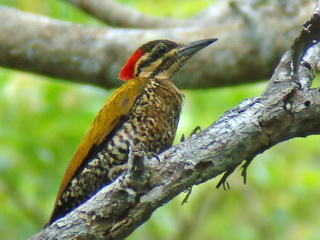
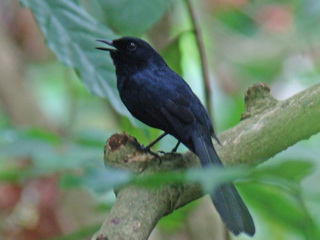
Spot-throated Flameback, PalawanAnd another Palawan endemic; White-vented Shama
-_-_-_-_-_-_-_-_-_-_-_-_-_-_-_-_-_-_-_-
Our tour's bird list (pdf file)
-_-_-_-_-_-_-_-_-_-_-_-_-_-_-_-_-_-_-_-
William Price's photo gallery of this
tour; http://www.pbase.com/tereksandpiper/philippines
Hi there Stijn
I hope you got home quickly and safely and that your wife
and daughter are well and pleased to see you! This is just a
quick note to thank you (and big Pete) for a really good
trip to the Philippines. Some wonderful birds, good food and
good company, all brought about by your skilful organization
and planning. And we all felt perfectly safe for the whole
trip!
So thanks again and I hope to join another Birding2Asia tour
sometime in the future.
Best wishes
Tim
Hello Stijn,
Thanks a lot for the nice photos and a very successful tour,
it sure brings back good memories.
Best wishes,
Johni
Stijn,
Thank you so much for an excellent birding adventure. I have
been on many international birding trips and this was a very
good one. You were an excellent host and guide.
The trip home was uneventful and had shorter flights than
anticipated due to a tailwind of up to 150 knots. From the
hotel in Manila to my home it took about 27 hours. Spring is
in full swing here with many flowers in bloom. Yesterday I
mowed the lawn. Since the first of December there has been
over a meter of rain so everything is nice and green.
Someday I hope that I will have the pleasure of birding with
you again, perhaps in Taiwan or Thailand.
Calvin
Hi Stijn,
Your photos bring back good memories indeed, and thanks for
sending. I know you're a good bird photographer, but I'm
glad to have these people shots since I didn't have a small
lens with me. Earlier today, Calvin and I were trading
messages and we agreed you and also Pete were very good
about not letting your photography hinder your guiding work.
Mark

